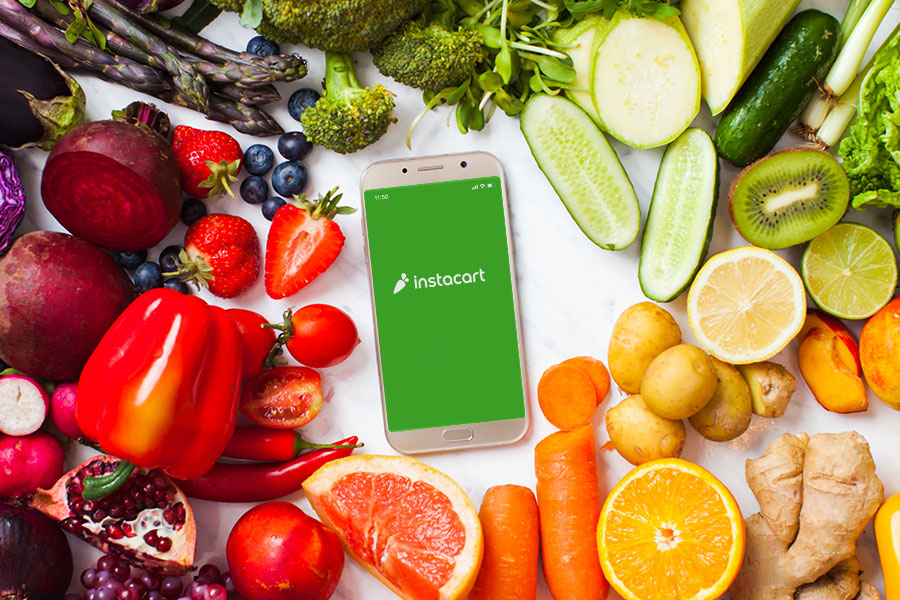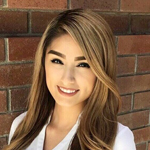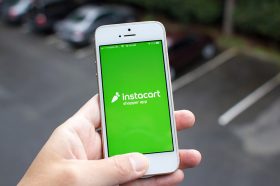Resources - Blog
What Brands Need to Know About Instacart

Stay on top of the latest e-commerce and marketplace trends.
The grocery delivery market skyrocketed after the COVID-19 outbreak as consumers are ordering food and pantry goods online more than ever before.
Online grocery currently makes up 10.2% of the grocery market and is projected to account for 20%–25% of the category by 2025, according to a study by Mercatus.
Grocers that did not offer a delivery service turned to Instacart, or competing third-party services, to reach more shoppers. Some large retailers began building out their existing grocery delivery capabilities to meet the new buyer behavior while leveraging Instacart simultaneously.
Since Instacart has established itself as a leading grocery delivery service, it expanded its offerings by providing deliveries for non-grocery retailers, such as Best Buy, Sephora, Dick’s Sporting Goods, and more. The company also plans to enhance its current advertising features.
Below are what brands need to know about Instacart.
Many Grocers and Large Retailers Adopted Instacart
Many grocers have started relying on Instacart to keep up with the consumer demand for grocery deliveries and in-store pick up after the COVID-19 outbreak. Instacart enabled grocers to enter into the e-commerce space and drive product visibility on a platform with a large audience. Major retailers have also begun using Instacart, in conjunction with their own delivery services, to broaden their customer reach.
Instacart has also significantly profited from the unprecedented rise in grocery deliveries as it became the go-to solution for many grocers in their efforts to remain competitive in the category. Instacart’s share of online grocery reached 55% in May 2020 and it occasionally sees a 500% increase in orders, per RetailWire. The grocery delivery provider currently works with over 500 companies, including non-grocery retailers.
The Tradeoffs of Partnering with Instacart
After the initial move to partner with Instacart and utilize its delivery and pick-up services, grocers and large retailers began noticing the challenges that came with their decision. They have little control over the customer experience as Instacart’s personnel selects the food items and prepares them for deliveries or in-store pick up. Grocers and retailers are also unable to access valuable consumer data, unless they sign up for Instacart’s advertising service.
Instacart also charges its business partners a commission of over 10% on every transaction. While the amount may not seem daunting at first glance, it accumulates and may reduce your budget for other business functions, like marketing.
Despite the drawbacks mentioned, Instacart also provides grocers’ and major retailers’ opportunities for growth. Grocers that did not offer delivery services prior to the pandemic were able to adapt to the new buyer behavior by partnering with Instacart.
The third-party service allowed grocers to tap into its large network of shoppers and gain net new customers. Retail giants, on the other hand, benefit from Instacart’s services by offering deliveries to customers in regions its own delivery service does not cover and learning from the company’s operations to better compete with it in the future.
Advertising Features
Instacart’s advertising service is simple and straightforward. However, the company is currently working on expanding its advertising capabilities, which will drive greater discoverability and sales for brands on its digital marketplace. Instacart’s decision to enhance its advertising service is not surprising since retailers, such as Walmart and Amazon, have seen positive results from broadening their advertising features.
As of now, Instacart offers brands a self-serve type of campaign, known as Featured Product ads. Brands have the choice of selecting from either an auto or manual targeting option. The ads will appear next to relevant products (auto targeting) or will populate based on selected keywords (manual targeting). Winning bids are determined by the cost-per-click (CPC) bid and the relevance of the search term. Instacart also allows brands to offer promotions and discounts.
Brands can calculate the probability of winning a bid with Instacart’s unique keyword rating guide that adjusts in real-time. Furthermore, Instacart separates advertisers into four distinctive tiers. The company provides more consumer data to the brands that have a greater investment into its advertising service. Brands that have a large advertising budget will be able to build more effective ad campaigns.
Instacart plans to grow its advertising service into a multi-billion-dollar business by expanding its offerings. A representative from Instacart revealed that the company intends to add new features as early as Q1 this year, which include: email campaigns, campaigns focused on awareness, placement bid boosting, broad match types, new product discovery, and new products to self-serve.
Final Thoughts
Instacart has grown tremendously due to the shift in consumer behavior, which resulted in an increase of grocers and large retailers using its service. While there are some disadvantages to using Instacart, the company is helping grocers provide delivery and pick-up services to their customers and supports major retailers in broadening the reach of their delivery operations.
In contrast, brands are benefiting from the massive Instacart adoption as their products are now seen across a larger audience. Brands should consider investing in Instacart’s advertising service to gain valuable consumer data and maximize their sales on the platform, especially since new features will be introduced.
Learn what Feedvisor can do for your business.
When you partner with Feedvisor, you automatically receive access to our true, AI-driven technology and hands-on team of e-commerce experts. Contact one of our team members today to learn more about our end-to-end solution for brands and large sellers on Amazon, Walmart, and e-marketplaces.




